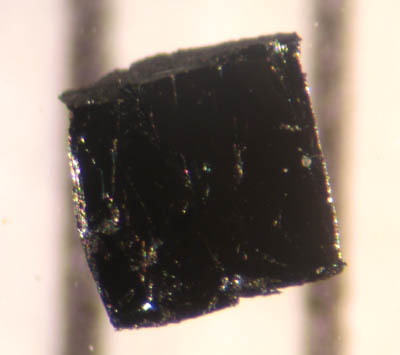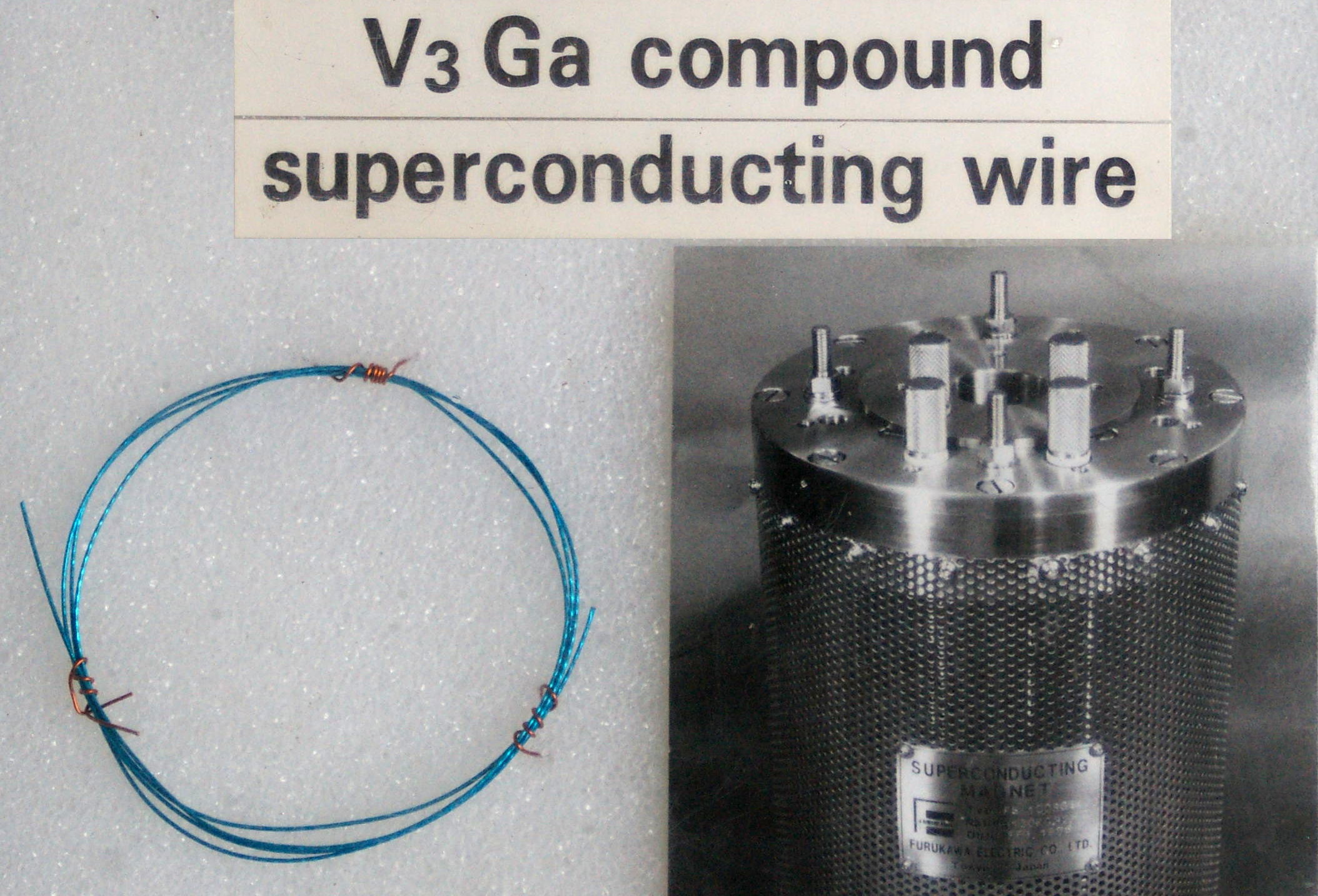|
Superconductors
Superconductivity is a set of physical properties observed in certain materials where electrical resistance vanishes and magnetic flux fields are expelled from the material. Any material exhibiting these properties is a superconductor. Unlike an ordinary metallic conductor, whose resistance decreases gradually as its temperature is lowered even down to near absolute zero, a superconductor has a characteristic critical temperature below which the resistance drops abruptly to zero. An electric current through a loop of superconducting wire can persist indefinitely with no power source. The superconductivity phenomenon was discovered in 1911 by Dutch physicist Heike Kamerlingh Onnes. Like ferromagnetism and atomic spectral lines, superconductivity is a phenomenon which can only be explained by quantum mechanics. It is characterized by the Meissner effect, the complete ejection of magnetic field lines from the interior of the superconductor during its transitions into the ... [...More Info...] [...Related Items...] OR: [Wikipedia] [Google] [Baidu] |
High-temperature Superconductors
High-temperature superconductors (abbreviated high-c or HTS) are defined as materials that behave as superconductors at temperatures above , the boiling point of liquid nitrogen. The adjective "high temperature" is only in respect to previously known superconductors, which function at even colder temperatures close to absolute zero. In absolute terms, these "high temperatures" are still far below ambient, and therefore require cooling. The first high-temperature superconductor was discovered in 1986, by IBM researchers Johannes Georg Bednorz, Bednorz and Karl Alexander Müller, Müller, who were awarded the Nobel Prize in Physics in 1987 "for their important break-through in the discovery of superconductivity in ceramic materials". Most high-c materials are type-II superconductors. The major advantage of high-temperature superconductors is that they can be cooled by using liquid nitrogen, as opposed to the previously known superconductors which require expensive and hard-to ... [...More Info...] [...Related Items...] OR: [Wikipedia] [Google] [Baidu] |
Type II Superconductor
In superconductivity, a type-II superconductor is a superconductor that exhibits an intermediate phase of mixed ordinary and superconducting properties at intermediate temperature and fields above the superconducting phases. It also features the formation of magnetic field vortices with an applied external magnetic field. This occurs above a certain critical field strength ''Hc1''. The vortex density increases with increasing field strength. At a higher critical field ''Hc2'', superconductivity is destroyed. Type-II superconductors do not exhibit a complete Meissner effect. History In 1935, Rjabinin and Shubnikov experimentally discovered the Type-II superconductors. In 1950, the theory of the two types of superconductors was further developed by Lev Landau and Vitaly Ginzburg in their paper on Ginzburg–Landau theory. In their argument, a type-I superconductor had positive free energy of the superconductor-normal metal boundary. Ginzburg and Landau pointed out the possibili ... [...More Info...] [...Related Items...] OR: [Wikipedia] [Google] [Baidu] |
Unconventional Superconductor
Unconventional superconductors are materials that display superconductivity which does not conform to either the conventional BCS theory or Nikolay Bogolyubov's theory or its extensions. History The superconducting properties of CeCu2Si2, a type of heavy fermion material, were reported in 1979 by Frank Steglich. For a long time it was believed that CeCu2Si2 was a singlet d-wave superconductor, but since the mid 2010s, this notion has been strongly contested. In the early eighties, many more unconventional, heavy fermion superconductors were discovered, including UBe13, UPt3 and URu2Si2. In each of these materials, the anisotropic nature of the pairing was implicated by the power-law dependence of the nuclear magnetic resonance (NMR) relaxation rate and specific heat capacity on temperature. The presence of nodes in the superconducting gap of UPt3 was confirmed in 1986 from the polarization dependence of the ultrasound attenuation. The first unconventional triplet superconduc ... [...More Info...] [...Related Items...] OR: [Wikipedia] [Google] [Baidu] |
Cuprate Superconductor
Cuprate superconductors are a family of high-temperature superconducting materials made of layers of copper oxides (CuO2) alternating with layers of other metal oxides, which act as charge reservoirs. At ambient pressure, cuprate superconductors are the highest temperature superconductors known. However, the mechanism by which superconductivity occurs is still not understood. History The first cuprate superconductor was found in 1986 in the non-stoichiometric cuprate lanthanum barium copper oxide by IBM researchers Georg Bednorz and Karl Alex Müller. The critical temperature for this material was 35K, well above the previous record of 23 K. The discovery led to a sharp increase in research on the cuprates, resulting in thousands of publications between 1986 and 2001. Bednorz and Müller were awarded the Nobel Prize in Physics in 1987, only a year after their discovery. [...More Info...] [...Related Items...] OR: [Wikipedia] [Google] [Baidu] |
BCS Theory
BCS theory or Bardeen–Cooper–Schrieffer theory (named after John Bardeen, Leon Cooper, and John Robert Schrieffer) is the first microscopic theory of superconductivity since Heike Kamerlingh Onnes's 1911 discovery. The theory describes superconductivity as a microscopic effect caused by a condensation of Cooper pairs. The theory is also used in nuclear physics to describe the pairing interaction between nucleons in an atomic nucleus. It was proposed by Bardeen, Cooper, and Schrieffer in 1957; they received the Nobel Prize in Physics for this theory in 1972. History Rapid progress in the understanding of superconductivity gained momentum in the mid-1950s. It began with the 1948 paper, "On the Problem of the Molecular Theory of Superconductivity", where Fritz London proposed that the phenomenological London equations may be consequences of the coherence of a quantum state. In 1953, Brian Pippard, motivated by penetration experiments, proposed that this would modify ... [...More Info...] [...Related Items...] OR: [Wikipedia] [Google] [Baidu] |
Meissner Effect
The Meissner effect (or Meissner–Ochsenfeld effect) is the expulsion of a magnetic field from a superconductor during its transition to the superconducting state when it is cooled below the critical temperature. This expulsion will repel a nearby magnet. The German physicists Walther Meissner and Robert Ochsenfeld discovered this phenomenon in 1933 by measuring the magnetic field distribution outside superconducting tin and lead samples. The samples, in the presence of an applied magnetic field, were cooled below their superconducting transition temperature, whereupon the samples cancelled nearly all interior magnetic fields. They detected this effect only indirectly because the magnetic flux is conserved by a superconductor: when the interior field decreases, the exterior field increases. The experiment demonstrated for the first time that superconductors were more than just perfect conductors and provided a uniquely defining property of the superconductor state. The abilit ... [...More Info...] [...Related Items...] OR: [Wikipedia] [Google] [Baidu] |
Conventional Superconductor
Conventional superconductors are materials that display superconductivity as described by BCS theory or its extensions. This is in contrast to unconventional superconductors, which do not. Conventional superconductors can be either type-I or type-II. Most elemental An elemental is a mythic being that is described in occult and alchemical works from around the time of the European Renaissance, and particularly elaborated in the 16th century works of Paracelsus. According to Paracelsus and his subsequent fol ... superconductors are conventional. Niobium and vanadium are type-II, while most other elemental superconductors are type-I. Critical temperatures of some elemental superconductors: Most compound and alloy superconductors are type-II materials. The most commonly used conventional superconductor in applications is a niobium-titanium alloy - this is a type-II superconductor with a superconducting critical temperature of 11 K. The highest critical temperature so far achiev ... [...More Info...] [...Related Items...] OR: [Wikipedia] [Google] [Baidu] |
Superconducting Wire
Superconducting wires are electrical wires made of superconductive material. When cooled below their transition temperatures, they have zero electrical resistance. Most commonly, conventional superconductors such as niobium-titanium are used, but high-temperature superconductors such as YBCO are entering the market. Superconducting wire's advantages over copper or aluminum include higher maximum current densities and zero power dissipation. Its disadvantages include the cost of refrigeration of the wires to superconducting temperatures (often requiring cryogens such as liquid nitrogen or liquid helium), the danger of the wire quenching (a sudden loss of superconductivity), the inferior mechanical properties of some superconductors, and the cost of wire materials and construction. Its main application is in superconducting magnets, which are used in scientific and medical equipment where high magnetic fields are necessary. Important parameters The construction and operatin ... [...More Info...] [...Related Items...] OR: [Wikipedia] [Google] [Baidu] |
Quantum Vortex
In physics, a quantum vortex represents a quantized flux circulation of some physical quantity. In most cases, quantum vortices are a type of topological defect exhibited in superfluids and superconductors. The existence of quantum vortices was first predicted by Lars Onsager in 1949 in connection with superfluid helium. Onsager reasoned that quantisation of vorticity is a direct consequence of the existence of a superfluid order parameter as a spatially continuous wavefunction. Onsager also pointed out that quantum vortices describe the circulation of superfluid and conjectured that their excitations are responsible for superfluid phase transitions. These ideas of Onsager were further developed by Richard Feynman in 1955 and in 1957 were applied to describe the magnetic phase diagram of type-II superconductors by Alexei Alexeyevich Abrikosov. In 1935 Fritz London published a very closely related work on magnetic flux quantization in superconductors. London's fluxoid can also be vi ... [...More Info...] [...Related Items...] OR: [Wikipedia] [Google] [Baidu] |
Type I Superconductor
The interior of a bulk superconductor cannot be penetrated by a weak magnetic field, a phenomenon known as the Meissner effect. When the applied magnetic field becomes too large, superconductivity breaks down. Superconductors can be divided into two types according to how this breakdown occurs. In type-I superconductors, superconductivity is abruptly destroyed via a first order phase transition when the strength of the applied field rises above a critical value ''H''c. This type of superconductivity is normally exhibited by pure metals, e.g. aluminium, lead, and mercury. The only alloy known up to now which exhibits type I superconductivity is TaSi2. The covalent superconductor SiC:B, silicon carbide heavily doped with boron, is also type-I. Depending on the demagnetization factor, one may obtain an intermediate state. This state, first described by Lev Landau, is a phase separation into macroscopic non-superconducting and superconducting domains forming a Husimi Q representatio ... [...More Info...] [...Related Items...] OR: [Wikipedia] [Google] [Baidu] |
Magnetic Field
A magnetic field is a vector field that describes the magnetic influence on moving electric charges, electric currents, and magnetic materials. A moving charge in a magnetic field experiences a force perpendicular to its own velocity and to the magnetic field. A permanent magnet's magnetic field pulls on ferromagnetic materials such as iron, and attracts or repels other magnets. In addition, a nonuniform magnetic field exerts minuscule forces on "nonmagnetic" materials by three other magnetic effects: paramagnetism, diamagnetism, and antiferromagnetism, although these forces are usually so small they can only be detected by laboratory equipment. Magnetic fields surround magnetized materials, and are created by electric currents such as those used in electromagnets, and by electric fields varying in time. Since both strength and direction of a magnetic field may vary with location, it is described mathematically by a function assigning a vector to each point of sp ... [...More Info...] [...Related Items...] OR: [Wikipedia] [Google] [Baidu] |
Electrical Resistance And Conductance
The electrical resistance of an object is a measure of its opposition to the flow of electric current. Its reciprocal quantity is , measuring the ease with which an electric current passes. Electrical resistance shares some conceptual parallels with mechanical friction. The SI unit of electrical resistance is the ohm (), while electrical conductance is measured in siemens (S) (formerly called the 'mho' and then represented by ). The resistance of an object depends in large part on the material it is made of. Objects made of electrical insulators like rubber tend to have very high resistance and low conductance, while objects made of electrical conductors like metals tend to have very low resistance and high conductance. This relationship is quantified by resistivity or conductivity. The nature of a material is not the only factor in resistance and conductance, however; it also depends on the size and shape of an object because these properties are extensive rather than i ... [...More Info...] [...Related Items...] OR: [Wikipedia] [Google] [Baidu] |






